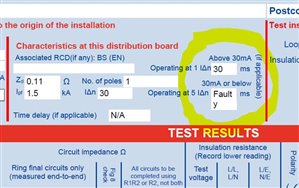


LB2:
I have spoken with another electrician to get a second opinion, he said that the test results seem strange, as the trip responded in 30ms above 30mA as it should, but marked faulty because it didn't trip below 30mA but electrician 2 seems to think that's by design and shouldn't trip with currents lower than 30mA.
I took this to mean that if the RCD is a 30 mA one (or 10 mA) it is tested at 5 times the value, but if it is > 30 mA (100 mA, 300 mA, etc.) it is tested at 1 times the value.
It need not trip below 30 mA, but should do so rapidly at 150 mA. On the face of it, it has not tripped at all.
We're about to take you to the IET registration website. Don't worry though, you'll be sent straight back to the community after completing the registration.
Continue to the IET registration site